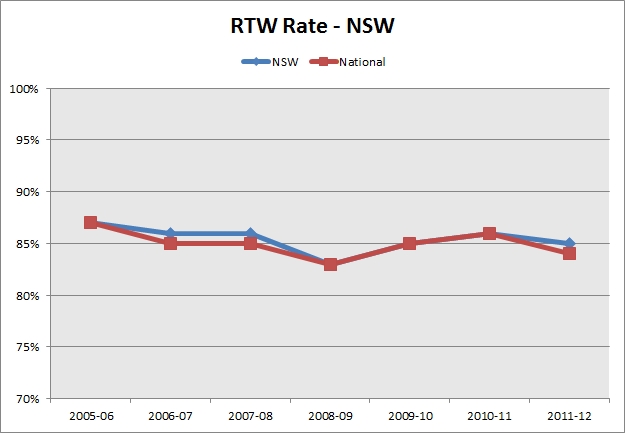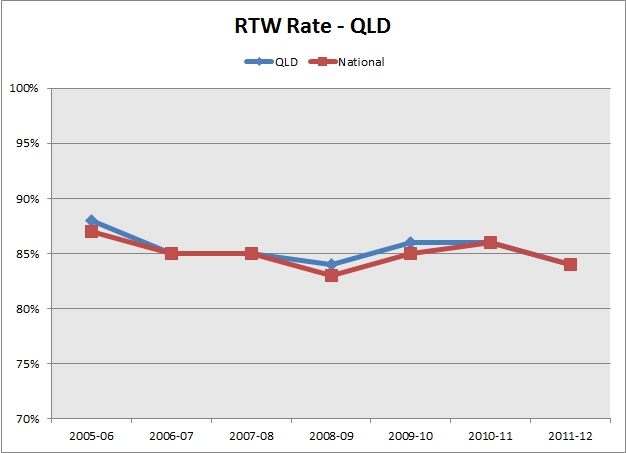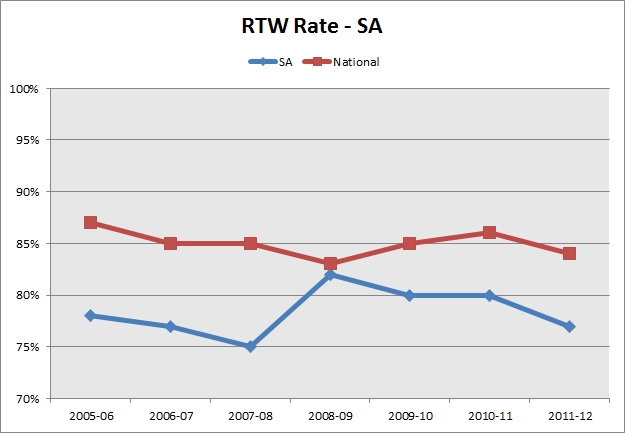RTW Rates in Australia and New Zealand, trends without benefits.

This article collates the headline return to work results across jurisdictions participating in the Return to Work Monitor. Further information regarding the Return to Work Monitor is below the graphs.
The graphs below show the return to work rate and the durable return to work rate for each jurisdiction.
The return to work rate is the percent of workers interviewed who say they have been back to work for at least a day between the time of their claim and the time of the interview. They may have stayed at work or ceased work. As long as they have been back at work at some point they are included in the return to work rate.
The durable RTW rate is the percentage of workers who had returned to work since their injury, and were still working at the time of the survey (about eight months post injury). This is a proxy measure for sustainable return to work.
Results:
The blue line represents the relevant jurisdiction, the red line the Australian (national) average results.
New Zealand (NZ) has continued to improve both return to work and durable return to work results since the drop in return to work performance associated with the global financial downturn. NZ is the only jurisdiction heading in a positive direction on both measures.
Victoria’s durable return to work rate has improved marginally.
In Tasmania and under Comcare return to work rates have remained the same or improved, but there has been a drop in durable return to work.
Across other jurisdictions, including the Australian average, there has been a drop in both return to work and durable return to work rates over the last 12 months.
While there is natural fluctuation from year to year, some jurisdictions have been trending downwards over a number of years. This is seen in the Northern Territory, Comcare and in recent years, Tasmania. A new injury management model was introduced in Tasmania about three years ago and return to work performance seems to have dropped since.
South Australia’s return to work performance had improved, but declining results over the last two years has seen those improvements lost.
Overall, despite many endeavours across a range of jurisdictions, return to work performance is not improving across Australia. There is an overall decline in durable or sustainable return to work across most jurisdictions. New Zealand is the best performer in the 2012 results.
Further, of those who are back at work, a gradually decreasing percentage are back doing their normal duties. The percent of those who are back at work included in the durable return to work group are working on reduced hours or modified / alternate duties.
| | |
| | 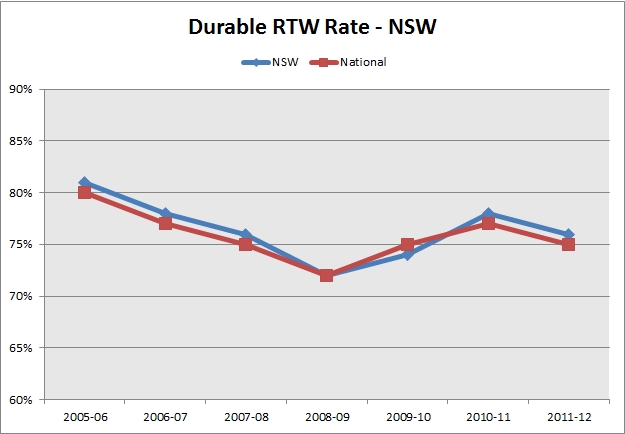 |
| |  |
| |  |
| |  |
| |  |
| |  |
 | 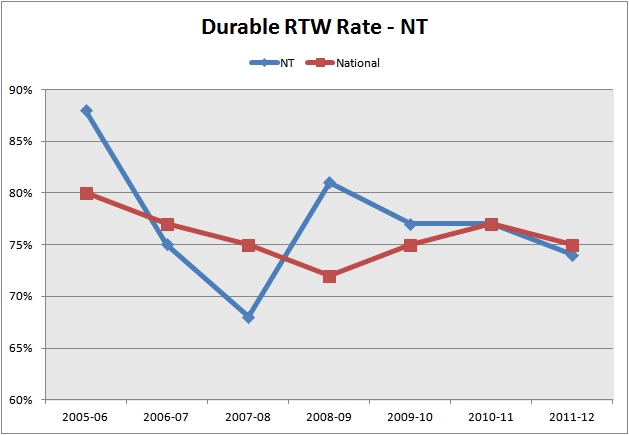 |
Background to the Return to Work Monitor:
The Return to Work Monitor is a survey of approximately 2000 injured workers in Australia and New Zealand. The Monitor asks people with work injuries about return to work.
The Monitor interviews employees seven to nine months after they have lodged a claim, where ten days or more compensation has been paid. The survey is completed by phone in November and May each year by Campbell Research & Consulting.
The RTW Monitor is designed to compare return to work outcomes and the processes involved in workers compensation schemes. Injured workers employed by organisations which are self-insured are not included.
Individual jurisdictions (systems that cover certain populations, such as the states and territories or systems such as Comcare) report on return to work outcomes through their own statistical reports. However these reports are based only on information within the relevant system's administrative database. They are able to report on outcomes such as days lost, costs, treatment costs, but not issues such as whether the person is back doing their normal job or restricted duties. They are not able to report on issues that influence return to work. In contrast, the RTW Monitor is able to ask employees about factors such as RTW assistance, workplace culture and insurer performance. The RTW Monitor also includes some information on claims provided by the jurisdiction, such as average claim costs.
The Monitor also allows comparison across the jurisdictions, whereas each system has variations in the way they collect and report on their jurisdictional information.
The Monitor was initiated by WorkSafe Victoria in 1993 and was subsequently introduced across other jurisdictions in Australia and New Zealand. Western Australia has not participated in the Monitor.
Tasmania is the only jurisdiction to publish their jurisdictional report.
RTW Matters has extracted the data from the last seven RTW Monitor reports and analysed the information on a jurisdictional basis.
Published 26 March, 2013 | Updated 11 June, 2013




